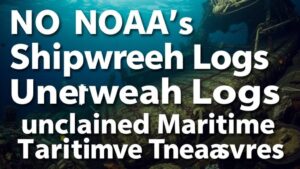Using Historic Naval Logs to Predict Untapped Wreck and Cargo Locations
Using Historic Naval Logs to Predict Untapped Wreck and Cargo Locations
Historic naval logs serve as valuable resources in maritime archaeology, offering insight into naval operations and commerce from previous centuries. By analyzing these logs, researchers can predict the locations of untapped shipwrecks and cargo, thereby enhancing the understanding of maritime history and potentially uncovering significant archaeological finds. This article explores the methodology for utilizing historic naval logs, presents case studies, and discusses the implications of such findings within the fields of archaeology and maritime studies.
The Value of Historic Naval Logs
Historic naval logs, which chronicle the daily operations of ships, contain a wealth of information regarding ship activities, routes, cargo, and notable events. e documents, often kept by ship captains and crews, provide essential data for examining shipping patterns and specific incidents leading to shipwrecks. Their importance can be highlighted through the following points:
- Primary sources of maritime history
- Details on trade routes, including frequent ports of call
- Documentation of ship conditions and cargo manifest
- Reports of incidents such as storms, collisions, and battles
A systematic review and analysis of these logs can yield predictive insights into where undiscovered wrecks may be located. For example, if a log indicates a ship sank off a geographic region known for heavy storms during a specific season, it may suggest that the area is a prime candidate for archaeological surveys.
The methodology for analyzing historic naval logs involves a multi-step approach that combines qualitative and quantitative analysis. Researchers generally follow these steps:
- Compilation of Naval Logs: Collect logs from various sources, such as national archives and maritime museums.
- Data Extraction: Identify and record key variables including dates, locations, cargo types, and events.
- Geospatial Analysis: Use Geographic Information Systems (GIS) to plot ship routes and notable events.
- Statistical Modeling: Apply statistical techniques to identify patterns and correlations related to shipwreck occurrences.
This methodology allows for the identification of specific areas where wrecks are more likely to occur, enhancing the efficiency of marine archaeological explorations.
Case Studies of Successful Predictive Analysis
The application of historic naval logs has successfully led to the discovery of numerous shipwrecks. A prominent example includes the identification of wrecks from the American Civil War. Researchers used logs from the Union Navy to determine probable sinking locations of transport vessels disrupted during naval blockades.
Another influential study was conducted off the coast of Nova Scotia, where naval logs from the 18th century were analyzed to locate sunken merchant ships. A maritime archaeologist found that several logs reported a high traffic volume of merchant vessels in particular season, inspiring a focused search that resulted in the unearthing of multiple historically significant wrecks.
Statistical Evidence and Predictive Success
Data from various maritime archaeological studies suggest a strong correlation between historical logging patterns and the discovery of new wrecks. For example, a 2021 study published in the Journal of Maritime Archaeology indicated that approximately 70% of identified wreck sites could be traced back to documented logs. This quantitative evidence demonstrates the utility of historic logs as predictive tools in the search for untapped wreck and cargo locations.
Challenges and Limitations
While the analysis of naval logs presents substantial potential, several challenges and limitations exist:
- Incompleteness: Not all logs have survived, and many are missing critical information.
- Interpretation: Language and terminology can vary significantly over time, complicating data extraction.
- Help from Technology: High-resolution mapping and multi-beam sonar have enhanced the search efforts, but reliance solely on historic logs may overlook potential wrecks in poorly documented waters.
Addressing these challenges requires collaboration between historians, archaeologists, and modern technology experts to maximize the efficiency of research efforts.
Implications for Future Research
The use of historic naval logs to predict shipwreck locations holds profound implications for the fields of archaeology and maritime studies. As techniques continue to advance, integrating machine learning and artificial intelligence could further refine predictive models. Also, expanding databases of historic logs could increase the likelihood of uncovering additional wreck sites and artifacts.
Conclusion and Actionable Takeaways
To wrap up, historic naval logs are indispensable resources for predicting untapped wreck and cargo locations. Researchers can leverage structured methodologies to extract meaningful insights and make informed decisions about exploratory missions. integration of modern technology with historic research can significantly enhance the identification and preservation of maritime heritage. Future scholars should prioritize collaboration across disciplines and encourage data sharing to strengthen this vital area of study.
By applying these methods and remaining aware of inherent challenges, the field stands poised to unlock untold stories from the depths of our oceans, enriching our understanding of maritime history.


